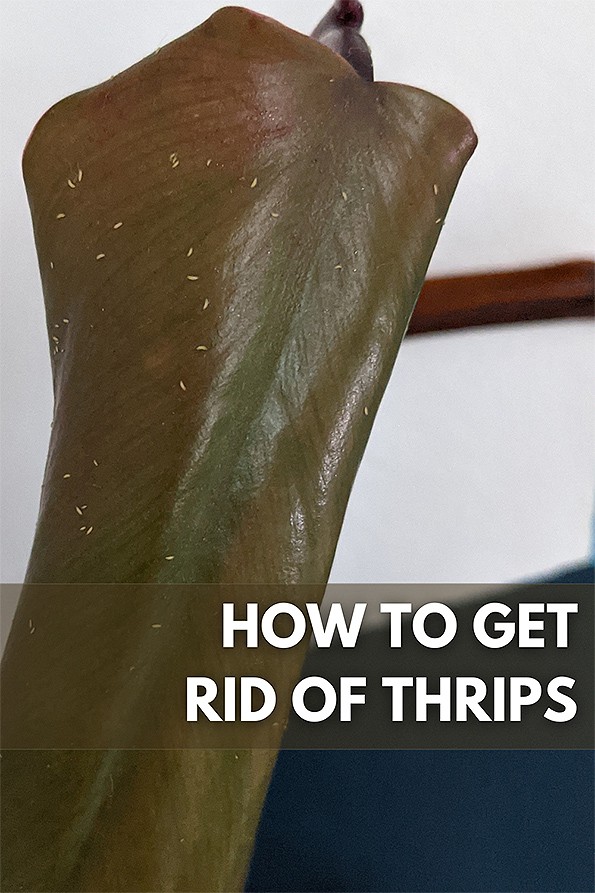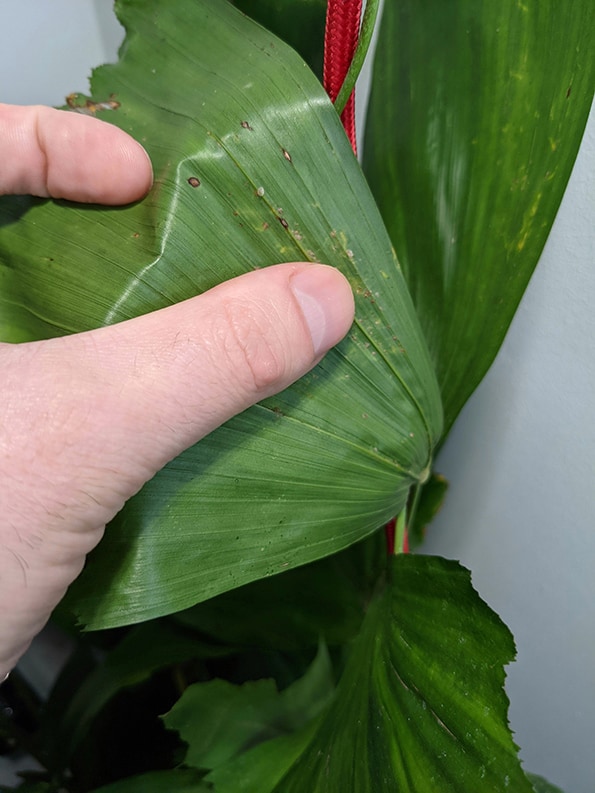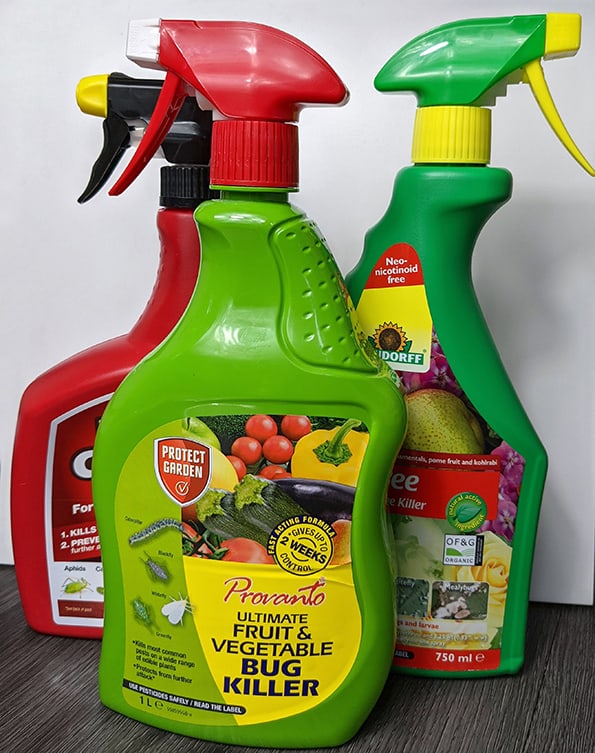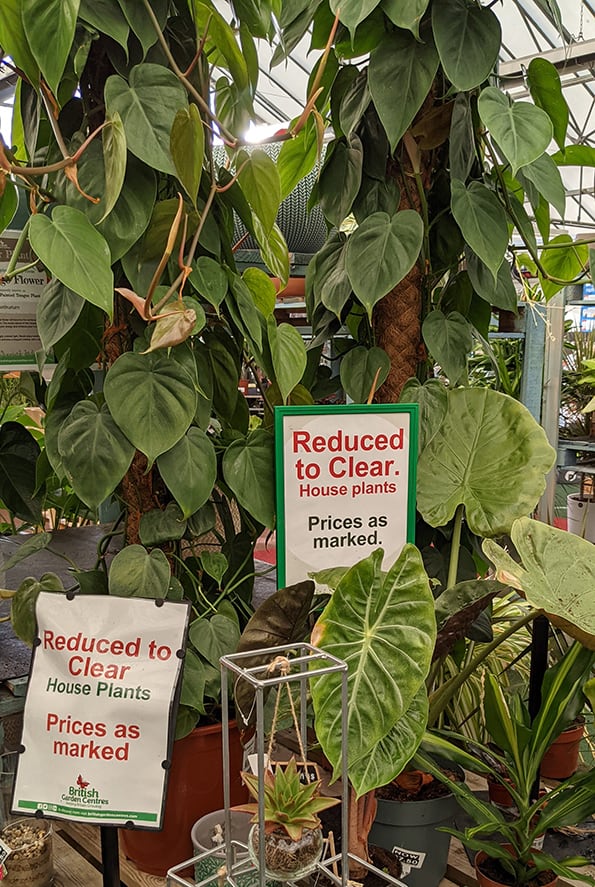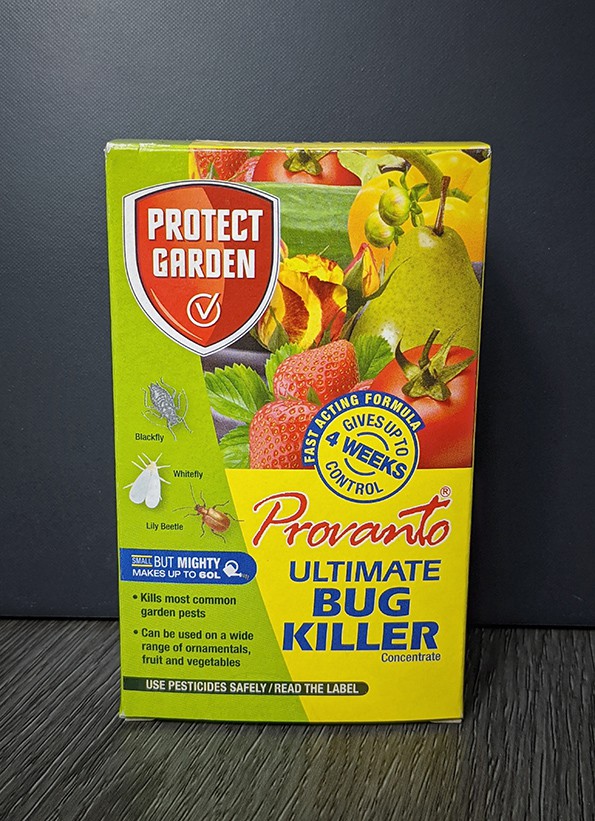Do you have a Thrips problem? Are they destroying your indoor plant collection?
After growing houseplants for 20 years, I've run into my fair share of Thrips. It's a common problem many owners will face sooner or later.
For me, they're the worst pest I've had to deal with. They're destructive and can spread to other plants in your home. If that wasn't bad enough, they're often very persistent and seem to subscribe to Arnold Schwarzenegger's "I'll be back" mantra.
Thrips (order Thysanoptera) are also known as Thunder Flies and can be hard work to get rid of. But it can be done and I'll show you how.
This article shares my experiences and will give some tried and tested ways to eliminate Thrips from your indoor plants. Let's get started.

Hi, I'm Tom!
If you're like me and enjoy the challenge of growing houseplants and getting them to thrive, then Ourhouseplants can help. This website shares my knowledge and years of growing plants and provides (hopefully) helpful advice on properly caring for your indoor plant friends.
Perhaps it goes without saying you first need to establish if you even have a problem. The signs and symptoms of thrips include tiny insects that are often yellow or black.
They can be seen with the naked eye if you look carefully enough. If you're unsure, gently blowing on them will cause them to start moving.
Other indications of the insects being present include little black spots on the leaves and tiny droplets of random plant sap ozzing from the affected plant leaves.
Yellowing and mottling leaves are also very typical. However, this can often signify other common houseplant issues, such as overwatering or underfeeding. I have a separate guide showing thrips damage and what to look for. I've included lots of photos so you can compare with your own plants.
Thrips have six lifecycle stages and several of these make them immune to some treatments. This means that in most cases, you'll have to treat any overrun plants several times to get rid of them fully.
Don't let this put you off. I've personally beaten them many times and I'll be telling you exactly how you do it.
Did you know that there is no such word as "Thrip"?
The word "Thrips" is actually a plural noun, meaning a single Thrip should, grammatically speaking, still be called "Thrips".
Some people feel very strongly about this, but I'm easy going. Feel free to tell me about your Thrip problem. I won't call you out on it.
The final thing you should decide is if you're an organic gardener or if you don't mind using chemicals.
I strongly encourage natural gardening where possible. However, getting rid of Thrips naturally is hard work, and I won't sugarcoat that fact.
You should also know if you don't get to grips with them fast, they can easily spread and destroy numerous plants in your collection within a few months. Gaining control of thrips quickly is essential if you want them gone. Especially during warm weather when they're breeding and growing at their fastest.
Cards on the table. In my honest and personal experience, natural gardening with Thrips is a battle that's rarely won. I will share some organic treatment ideas which I'll detail below. But I always have some chemical control waiting in the wings.
To effectively get rid of Thrips, follow these ideas. You don't need to use every single one, but the more steps you can tick off the better your chance of getting rid of them for good.
1
Thrips can be tricky to remove. You need to gradually reduce their numbers and having them spreading to other plants just makes things more difficult. So, isolating the host plant from healthy ones will help with this.
2
If they're feeding and, you can see large numbers of these slender insects in a small area. It might be simpler just to remove the affected leaf or flower bud, etc.
Success will come when Thrip numbers reduce, so removing them like this will help you reach this goal. Additionally, very badly damaged leaves will ruin the look of your plant and you'll probably end up removing them sooner or later anyway.
If you have just a handful of Thrips in an area with minimal leaf damage skip this step.
3
Thrips spend some of their lifecycles hiding in the debris resting on top of the potting soil. Remove their home by clearing off any waste matter or fallen leaves.
Remember there could be live Thrips attached to this plant debris as you're moving them out of your home. Take care you don't dislodge and spread them onto other healthy plants as you go.
4
You can use your fingers to get your squish on. Some people don't like doing this. If truth be told, I don't either.
Ultimately, you want them gone and because they're not simply going to go if you ask them nicely, they're only leaving one way unfortunatly. However, further methods covered later take longer to work and will only prolong the inevitable.
So, if you're up for it, you can quickly remove many Thrips at various stages of development using just your fingers. Press firmly and then wipe them off.
Although it's unpopular, physically removing Thrips with your fingers does work well. You can thoroughly reduce numbers with just a few minutes work. You can then move on to the final steps to get rid of the remaining ones.
It's best to complete this step prior to spraying any chemicals around. However, in all cases, be sure to wash your hands thoroughly afterwards.
5
Neem oil is a natural insecticide that can be sprayed onto plants. It disrupts the feeding and reproductive abilities of Thrips. Spinosad affects the nervous system of insects that eat or touch it. Insecticidal Soap has a similar effect without harming the plant.
More about Neem Oil
If you want to learn more about Neem, including how to use it and how to make a DIY spray, then I've got you covered.
Generally, all three are considered natural solutions and safe for people and pets, particularly Neem and some soaps. But your definition of natural might vary.
People are more cautious of Spinosad however and there is some evidence it can cause harm to beneficial insects. If you do use it, then do use it responsibly.
However, in general, you will be unlikely to eliminate your Thrip problem without using Neem Oil, Insecticidal Soap or the chemical based options coming up next.
6
Pyrethroids and Pyrethrin-based insecticides are often effective against Thrips. Sometimes they're the only thing that works.
Pyrethrin is a natural substance found within chrysanthemum flowers. Pyrethroids are the synthetic versions. They all work in similar ways and plants will usually need at least two treatments, a week or two apart to be fully effective.
They're powerful because they're systemic insecticides with a reasonable level of persistence (they normally last a few weeks). This means they're absorbed by the plant and transported through its tissues. Making the plant toxic to insects that feed on plant tissue such as Thrips.
When using an insecticidal spray like these be sure to spray all over the plant including on the undersides of the leaves. Follow the label directions and only apply as directed.
I do understand people's hesitation about using chemical products.
All I can say is that the ones for sale will have passed the safely threshold within your jurisdiction. You can treat plants outside of your home to limit the spray contaminating areas inside. (But if you do this, be careful because it will negatively affect beneficial insects that come into contact with them).
There is often a wide selection available in plant stores and you can also get some of the more popular ones on Amazon (affiliate link).
7
The final step is to repeat the steps in a week or so. Yes, it's frustrating it can't be resolved all in one go like many other pest problems. But Thrips are resilient insects due to their lifecycle providing immunity from actions you might take in some of the steps.
Repeat applications to disrupt the life cycle is often needed. Everything I've written above is based on my own experience. I used to fear Thrips because of how much significant damage they cause. But these days, I'm confident I can get to grips with them and there is no reason you can't either.
If you're feeling overwhelmed, take a deep breath and go to step one. You've got this.
I have more tips and some FaQ's next to provide additional insight.
Controlling thrips when you get them is tricky but preventing thrips entirely is even harder. Although, if you're prone to them, follow a few simple preventive measures, and you can reduce the chances of them taking hold.
One of the main ways Thrips are spread is by bringing a plant into your home that's already infested with them.
So to prevent thrips from being brought inside, take care to examine any new houseplant before you buy it. Where that's not possible, or you have concerns, think about isolating them for several weeks before you move them into their final position.
Sometimes, a great deal awaits you in garden centers and nurseries in the clearance section. But a Thrip infestation could also be lurking. Before purchasing, inspect the entire plant including any flower buds before parting with your cash.
Houseplants that are reduced to clear can be an amazing bargain. But often, they will be sickly or situated next to sickly plants. The presence of thrips could have easily caused this, so be extra careful.
For early detection keep an eye on your plants. It's easy to just cast a quick look over them every week, perhaps whilst watering. Look for any leaves that look abnormal and if you see any, check both sides for any signs of Thrips.
Due to their small size use a magnifying glass if your eyesight isn't great. If you see these pests (or suspect them) act fast and start the treatment ideas covered earlier.
If you have regular encounters with Thrips then getting some sticky blue traps as a preventative could be helpful.
Thrips are attracted to blue colors so they're more likely to land on the blue sticky trap than your plants leaf in the first instance. If they don't make it to your plant they won't be laying any eggs.
Yellow traps are more common, but you can buy the blue ones from Amazon sellers (affiliate link).
I wouldn't normally suggest using a Neem oil spray or Insecticidal soap as a routine preventative measure. But it could be worthwhile if you have regular infestations after previous ones have been cleared out.
These treatments are fairly mild but could help stop small colonies of Thrips from growing into something more serious.
These are some of the common questions I've been asked before. If you still have a burning question after this, drop it in the comments below.
Generally Thrips thrive in hot, dry conditions so boosting humidity levels helps discourage this pest. However this isn't always possible and even when you can provide these conditions Thrips can still be a problem.
You can look at introducing predatory insects. Although this can be tricky and costly, especially on a small scale. If you want to try, then Anthocorid bugs (Minute Pirate bugs) and the Predatory mite, Phytoseiid, will deal with them.
If you do have an thrips infestation but don't want to look at natural predators, then read through my how to above. I give some other natural methods you could try.
It depends is the answer. Soapy water generated from dish soap is based on detergents and isn't a true soap. Although, it should still form a thin layer over the top of the insect, which means they're unable to breathe. So the adults would be gone.
However Thrips are small and could be hiding in areas your spray can't reach. Additionally, you're only targeting one stage in the life cycle. The egg and pupa stages would be immune to dish soap. This means you'll never get rid of them on the first few goes.
Using dish soap instead of proper horticultural insecticidal soap is a bit like painting a large wall with a small paint brush. You'll get there eventually, but it would be more effective to use the right tools for the job.
People will frequently confuse Fungus Gnats and Thrips. They can look similar in regard to them being black flying insects but they're very different.
Fungus Gnats are larger, fly and buzz around a lot more than Thrips. Fungus Gnats are also annoying rather than seriously damaging. I have a separate article if you want to learn more about them.
Any product containing deltamethrin would be my top recommendation. It works for me every single time. Something that works quickly and doesn't require me to constantly spray chemicals around is a major win for me.
Deltamethrin is a systematic insecticide belonging to the pyrethroid family. Pyrethroids, including deltamethrin, are synthetic counterparts to pyrethrins, which are naturally occurring insecticides found in chrysanthemum flowers.
Provanto Ultimate Bug Killer contains deltamethrin. It works well because it kills Thrips on contact and also acts as a systemic insecticide.
It can be sprayed directly on the bugs which can eliminate them, but its real advantage is that the plant will absorb the chemical and it will persist in the plant's tissue for several weeks.
Once absorbed the plant then transports it around itself and as it's doing this, the Thrips will consume the deltamethrin while feeding. This will quickly finish them off and tackle multiple development stages at once.
It's so effective that just one or two treatments a few weeks apart are often enough to remove them from a plant completely.
Thrips won't feed on all types of houseplants. But they're still quite fond of a wide variety of plants. Generally, they're attracted to Palms, like the Areca Palm and Parlour Palm.
They're also massive fans of any plant within the Araceae Family. This covers all Alocasia, Caladium, Dieffenbachia, Syngonium, Epipremnum, Aglaonema and Philodendrons.
A huge number of houseplants sold will fall into this list and this is why Thrips are such a common problem. If you're after "resistant to thrips plants" you should look at cacti and succulents.
